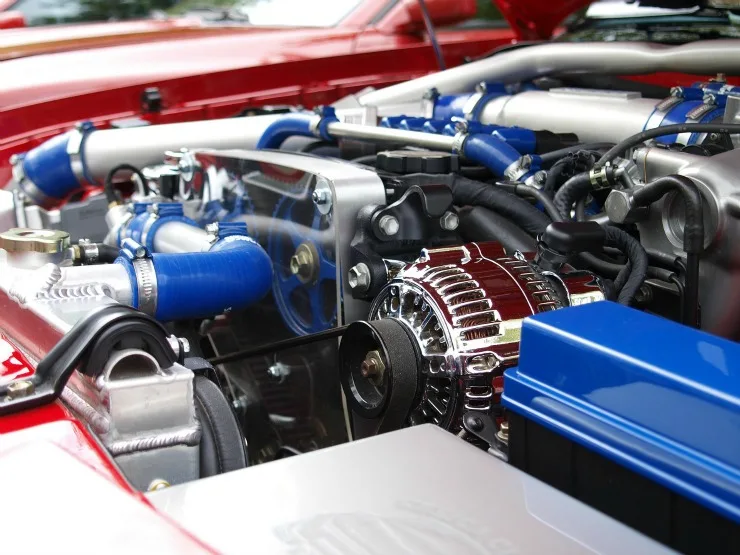This post may contain affiliate links. I only recommend products I use and love. Read the full disclosure here
Last Updated on November 2, 2017 by Alaina
From oil changes to tire balancing and rotation, it’s no lie that cars require a lot of love and care. And one of the most important parts to keep serviced is the car’s engine. Luckily, one of the engine’s most vital aspects, the fluids, are actually quite easy to monitor and maintain. Most of the time, all you need to do is lift up the hood and take a look. Checking engine fluids on a regular basis is a guaranteed way to save you both time and money, especially on down the road. Here are five of the most important engine fluids that should be checked and tips on when to check them:

ENGINE OIL
The engine oil is basically the engine’s life blood. It should be checked often and changed on a regular basis. Most newer models you can get away with checking it once a month. Older cars, more often. To check the oil level, you just pop up the hood, locate the oil dipstick, pull it out, and wipe it down. Repeat that again and you will know your oil level. If it’s in the safe level, you’re good to go. If it’s not, you need to add more.
Now how often your vehicle’s oil needs to be changed, will depend on the make and model. Again, most newer cars will not need it changed as often as older models do. To find out, always check your owner’s manual to know exactly when you should have the oil replaced, and make sure you follow that schedule.
TRANSMISSION FLUID
The transmission fluid is what keeps a car’s gears moving smoothly. It should also be checked on a monthly basis. You check it pretty much the same way you do the oil – with a dipstick – but in this case the car should be running. Unlike oil, a car’s transmission fluid is part of a closed system, so it should never be running low. If it is, take the vehicle to a certified mechanic so it can be checked. In addition, when checking the transmission fluid, you will also want to take into account the color and smell of the fluid. Good fluid will be reddish in color and not smell like it is burned. If it’s brown or smells burned, it is a sure sign that the fluid needs replacing.
For most cars, a good rule of thumb is to have the transmission fluid replaced every 50,000 to 100,000 miles. But again, check your owner’s manual to be sure.
COOLANT
The coolant, also known as antifreeze, is what keeps your car’s engine running cool. If you are low, chances are good that the car could overheat. An engine’s coolant should be checked at least twice a year, usually once before summer and again right before winter. The coolant is inside the radiator and can typically be checked by removing the radiator cap when the car is off and cool (never check it when the car is hot or running). Look inside the reservoir and you’ll see a line that the coolant should come up to. If it is low, you can add some more. Just make sure you add the same type of coolant that is currently in the car.
In addition, you should have the vehicle’s coolant system flushed, and the coolant replaced every 2 to 3 years, unless otherwise noted in your manual.
BRAKE FLUID
Brake fluid is what keeps your brakes working properly, so if they ever feel a little off, checking this fluid is the first step. A good rule of thumb is to check it every time you change the oil. You can check the level in the brake fluid reservoir by looking at the outside of the container. The container is clear and will have minimum and maximum fill lines. If it is a golden brown and filled to the full line, you are good to go. If it’s low, or brown in color, it is time to replace it. In addition, if you notice it is low, go ahead and fill it, but have the system checked professionally as well to ensure there isn’t a leak or other issue.
POWER STEERING FLUID
The power steering fluid is what helps keep your steering smooth and easy. On average, it should be checked about once a month. When low, you may start to hear a squealing sound when turning the wheel, and possibly even feel a “creaking” in the wheel. To check the power steering fluid, simply pop the hood and find the reservoir. In most cars you can see the level of fluid from the outside of the container. If it is low, it’s worth taking the car to a mechanic to find out why and ensure there is not a leak. As far as replacing the fluid, check your owner’s manual. Most car manuals recommend keeping the fluid level topped off, but you’ll rarely need to flush and replace it. Again, check your owner’s manual to make sure of any recommendations.
These five engine fluids play a very important role in keeping your vehicle running in top shape. And while all five of these engine fluids can be easily checked and topped off even by a novice, if you are not comfortable doing so, take your can into your dealership’s service department. Many dealerships, such as Sunset Chevrolet, even have online forms where you can quickly and easily schedule your next service appointment.
In addition, remember that there are other aspects of car care that should be performed on a regular schedule as well. Check your vehicle’s owner manual to keep up with the required maintenance to help keep your car running better, longer.
